标签:存储 斐波那契 exce 回收对象 追踪 源码分析 不能 slots soc
1、原理图说明
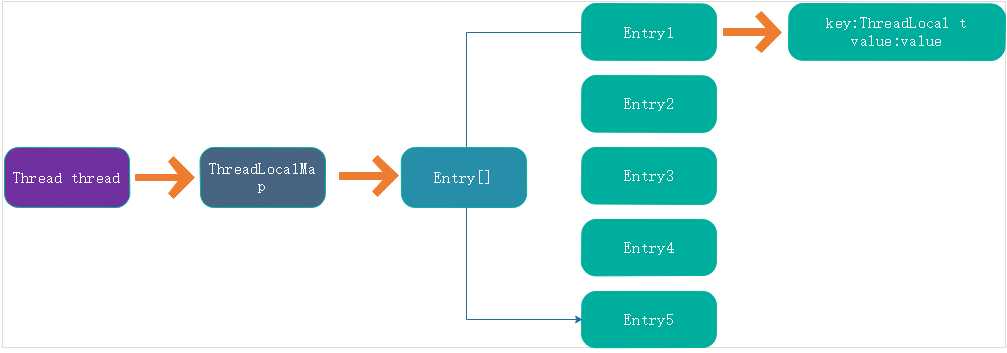
首先看这一张图,我们可以看出,每一个Thread类中都存在一个属性 ThreadLocalMap 成员,该成员是一个map数据结构,map中是一个Entry的数组,存在entry实体,该实体包含了 key value hash (注意 此map结构不包含next引用 所以不是使用的链地址方法)。
可以是用来存放 ThreadLocal对象以及对应的变量副本;
根据这个原理。我们可以知道在一个线程中可以存储多个 ThreadLocal 对象以及对应的value副本; 所以ThreadLocal 对象的作用就是用来为每一个线程 维护一个 副本;
我们使用ThreadLocal解决线程局部变量统一定义问题,多线程数据不能共享。(InheritableThreadLocal特例除外)不能解决并发问题。解决了:基于类级别的变量定义,每一个线程单独维护自己线程内的变量值(存、取、删的功能)
根据源码,画出原理图如下:
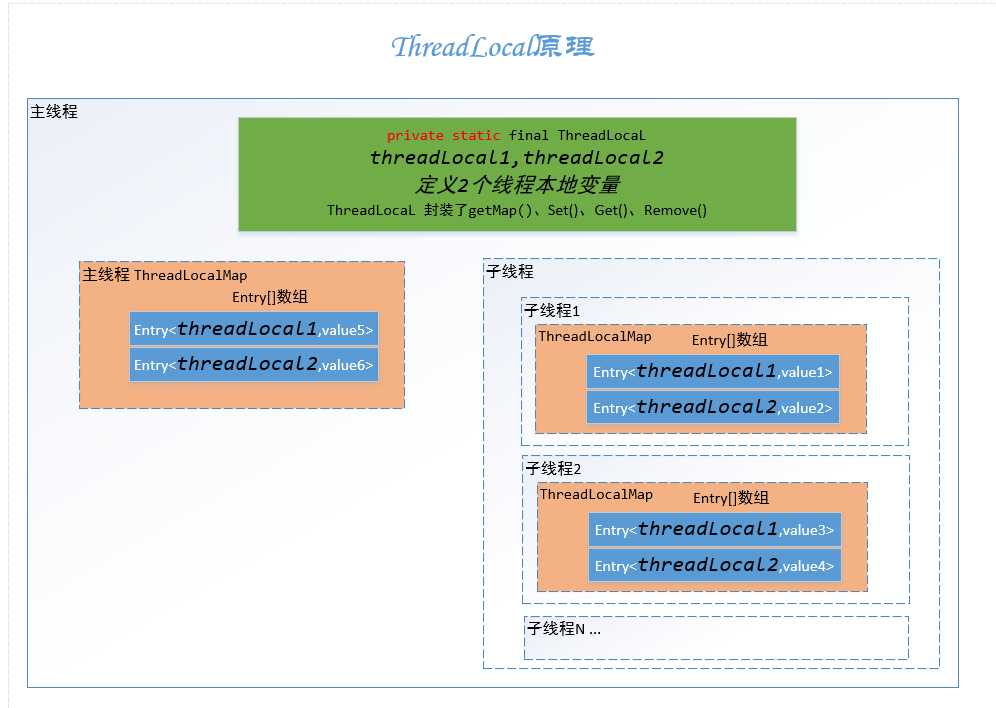
1.ThreadLocal类封装了getMap()、Set()、Get()、Remove()4个核心方法。
2.通过getMap()获取每个子线程Thread持有自己的ThreadLocalMap实例, 因此它们是不存在并发竞争的。可以理解为每个线程有自己的变量副本。
3.ThreadLocalMap中Entry[]数组存储数据,初始化长度16,后续每次都是2倍扩容。主线程中定义了几个变量,Entry[]才有几个key。
4.Entry的key是对ThreadLocal的弱引用,当ThreadLocal的对象没有被引用时,垃圾收集器会忽略这个key的引用而清理掉ThreadLocal对象, 防止了内存泄漏。
下图ThreadId类会在每个线程中生成唯一标识符。线程的id在第一次调用threadid.get()时被分配,在随后的调用中保持不变。
ThreadId类利用AtomicInteger原子方法getAndIncrement,为每个线程创建一个threadId变量,例如第一个线程是1,第二个线程是2...,并提供一个类静态get方法用以获取当前线程ID。:
1 import java.util.concurrent.atomic.AtomicInteger;
2
3 public class ThreadId {
4 // Atomic integer containing the next thread ID to be assigned
5 private static final AtomicInteger nextId = new AtomicInteger(0);
6
7 // Thread local variable containing each thread‘s ID
8 private static final ThreadLocal<Integer> threadId =
9 new ThreadLocal<Integer>() {
10 @Override protected Integer initialValue() { //为线程产生初始值
11 return nextId.getAndIncrement();
12 }
13 };
14
15 // Returns the current thread‘s unique ID, assigning it if necessary
16 public static int get() {
17 return threadId.get();
18 }
19 }
如上图,有一个注意点是:用户可以自定义initialValue()初始化方法,来初始化threadLocal的值。
我们来追踪一下ThreadLocal源码:
1 public T get() {
2 Thread t = Thread.currentThread();
3 ThreadLocalMap map = getMap(t);
4 if (map != null) {
//Entry 为 ThreadLocal 的静态内部类
5 ThreadLocalMap.Entry e = map.getEntry(this);
6 if (e != null) {
7 @SuppressWarnings("unchecked")
8 T result = (T)e.value;
9 return result;
10 }
11 }
//为空时 进行初始化
12 return setInitialValue();
13 }
14
21 private T setInitialValue() {
22 T value = initialValue();
23 Thread t = Thread.currentThread();
24 ThreadLocalMap map = getMap(t);
25 if (map != null)
26 map.set(this, value); //注意次数的this 指的是ThreadLocal对象 也就是说 entry中的键是 ThreadLocal
27 else
28 createMap(t, value);
29 return value;
30 }
31
41 public void set(T value) {
42 Thread t = Thread.currentThread();
43 ThreadLocalMap map = getMap(t);
44 if (map != null)
45 map.set(this, value);
46 else
47 createMap(t, value);
48 }
49
61 public void remove() {
62 ThreadLocalMap m = getMap(Thread.currentThread());
63 if (m != null)
64 m.remove(this);//相当于找到 键 后 删除掉整个Entry 实体
65 }
66
74 ThreadLocalMap getMap(Thread t) {
75 return t.threadLocals;
76 }
看源码我们知道不管是set、get、remove操作的都是ThreadLocalMap,key=ThreadLocal ,value=线程局部变量缓存值。
上图getMap最终调用的Thread的成员变量 ThreadLocal.ThreadLocalMap threadLocals,如下图:
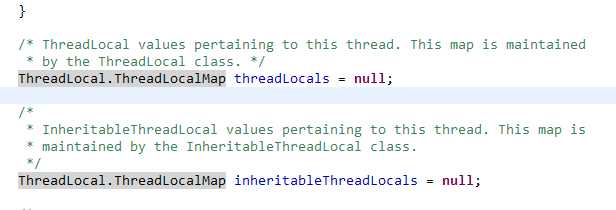
ThreadLocalMap是ThreadLocal的一个内部类,源码注释:
ThreadLocalMap是一个定制的哈希映射,仅适用于维护线程本地值。ThreadLocalMap类是包私有的,允许在Thread类中声明字段。为了帮助处理非常大且长时间的使用,哈希表entry使用了对键的弱引用。有助于GC回收。
~~~~~~~~~~~~~~~~~~~~~~~~~~~~~~~~~~~~~~~~~~~~~~~~~~~~~~~~~~~~~~~~~~~~~~~~~~ 分割线 ~~~~~~~~~~~~~~~~~~~~~~~~~~~~~~~~~~~~~~~~~~~~~~~~~~~~~~~~~~~~~~~~~~~~~~~~~~
0x61c88647ThreadLocal中定义了一个AtomicInteger,一个魔数0x61c88647,利用一定算法实现了元素的完美散列。
源码中元素散列算法如下:
1.求hashCode = i*HASH_INCREMENT+HASH_INCREMENT 每次新增一个元素(threadLocal)进Entry[],自增0x61c88647
2.元素散列位置(数组下标)= hashCode & (length-1),//为什么这样计算 详细看我的另一篇博客 hashmap的原理总结
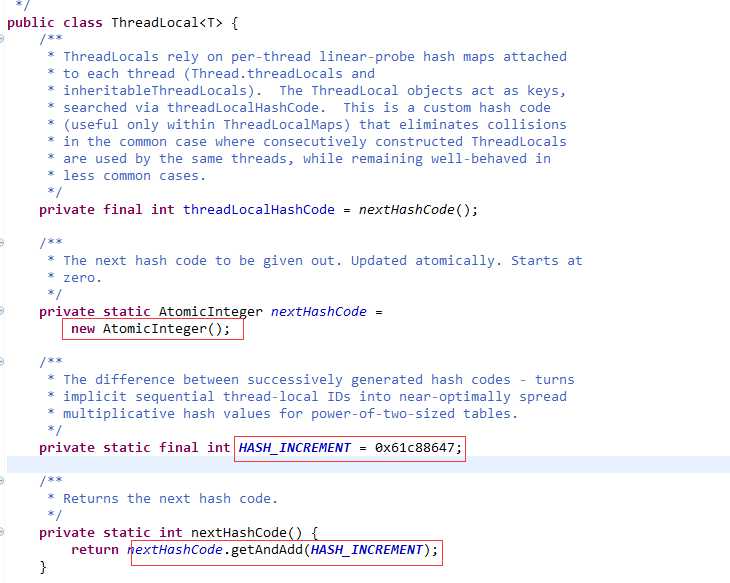
下面校验算法的散列性:
1 /** 2 * 3 * @ClassName:MagicHashCode 4 * @Description:ThreadLocalMap使用“开放寻址法”中最简单的“线性探测法”解决散列冲突问题 7 */ 8 public class MagicHashCode { 9 //ThreadLocal中定义的hash魔数 10 private static final int HASH_INCREMENT = 0x61c88647; 11 12 public static void main(String[] args) { 13 hashCode(16);//初始化16 14 hashCode(32);//后续2倍扩容 15 hashCode(64); 16 } 17 18 /** 19 * 20 * @Description 寻找散列下标(对应数组小标) 21 * @param length table长度 22 * @author diandian.zhang 23 * @date 2017年12月6日上午10:36:53 24 * @since JDK1.8 25 */ 26 private static void hashCode(Integer length){ 27 int hashCode = 0; 28 for(int i=0;i<length;i++){ 29 hashCode = i*HASH_INCREMENT+HASH_INCREMENT;//每次递增HASH_INCREMENT 30 System.out.print(hashCode & (length-1));//求散列下标,算法公式 31 System.out.print(" "); 32 } 33 System.out.println(); 34 } 35 }
运行结果:
7 14 5 12 3 10 1 8 15 6 13 4 11 2 9 0 --》Entry[]初始化容量为16时,元素完美散列
7 14 21 28 3 10 17 24 31 6 13 20 27 2 9 16 23 30 5 12 19 26 1 8 15 22 29 4 11 18 25 0--》Entry[]容量扩容2倍=32时,元素完美散列
7 14 21 28 35 42 49 56 63 6 13 20 27 34 41 48 55 62 5 12 19 26 33 40 47 54 61 4 11 18 25 32 39 46 53 60 3 10 17 24 31 38 45 52 59 2 9 16 23 30 37 44 51 58 1 8 15 22 29 36 43 50 57 0 --》Entry[]容量扩容2倍=64时,元素完美散列
根据运行结果,代表此算法在长度为2的N次方的数组上,确实可以完美散列。
那么原理是什么?
long l1 = (long) ((1L << 31) * (Math.sqrt(5) - 1));//(根号5-1)*2的31次方=(根号5-1)/2 *2的32次方=黄金分割数*2的32次方
System.out.println("as 32 bit unsigned: " + l1);//32位无符号整数
int i1 = (int) l1;
System.out.println("as 32 bit signed: " + i1);//32位有符号整数
System.out.println("MAGIC = " + 0x61c88647);
运行结果:
as 32 bit unsigned: 2654435769 as 32 bit signed: -1640531527 MAGIC = 1640531527
这里不再拓展,跟斐波那契数列(和黄金分割数)有关:
1.0x61c88647对应十进制=1640531527。
2.(根号5-1)*2的31次方,转换成long类型就是2654435769,转换成int类型就是-1640531527。
ThreadLocal的set最终调用了ThreadLocalMap的set方法,如下图
1 private void set(ThreadLocal<?> key, Object value) {
8 Entry[] tab = table;
9 int len = tab.length;
10 int i = key.threadLocalHashCode & (len-1);// 根据哈希码和数组长度求元素放置的位置,即数组下标
11 //从i开始往后一直遍历到数组最后一个Entry
12 for (Entry e = tab[i]; e != null; e = tab[i = nextIndex(i, len)]) {
15 ThreadLocal<?> k = e.get();
16 //如果key相等,覆盖value
17 if (k == key) {
18 e.value = value;
19 return;
20 }
21 //如果key为null,用新key、value覆盖,同时清理历史key=null的陈旧数据
22 if (k == null) {
23 replaceStaleEntry(key, value, i);
24 return;
25 }
26 }
27
28 tab[i] = new Entry(key, value);
29 int sz = ++size;
//如果超过阀值,就需要再哈希了
30 if (!cleanSomeSlots(i, sz) && sz >= threshold)
31 rehash();
32 }
再哈希:
1 private void rehash() {
2 expungeStaleEntries();// 清理一次陈旧数据 //保证数据及时 GC
3
4 // 清理完陈旧数据,如果>= 3/4阀值,就执行扩容,避免迟滞
5 if (size >= threshold - threshold / 4)
6 resize();
7 }
8
9 /**
10 * 把table扩容2倍,并把老数据重新哈希散列进新table
11 */
12 private void resize() {
13 Entry[] oldTab = table;
14 int oldLen = oldTab.length;
15 int newLen = oldLen * 2;
16 Entry[] newTab = new Entry[newLen];
17 int count = 0;
18 // 遍历Entry[]数组
19 for (int j = 0; j < oldLen; ++j) {
20 Entry e = oldTab[j];
21 if (e != null) {
22 ThreadLocal<?> k = e.get();
23 if (k == null) {// 如果key=null
24 e.value = null; // 把value也置null,有助于GC回收对象
25 } else {// 如果key!=null
26 int h = k.threadLocalHashCode & (newLen - 1);// 计算hash值
27 while (newTab[h] != null)// 如果这个位置已使用
28 h = nextIndex(h, newLen);// 线性往后查询,直到找到一个没有使用的位置,h递增
29 newTab[h] = e;//在第一个空节点上塞入Entry e
30 count++;// 计数++
31 }
32 }
33 }
34
35 setThreshold(newLen);// 设置新的阈值(实际set方法用了2/3的newLen作为阈值)
36 size = count;// 设置ThreadLocalMap的元素个数
37 table = newTab;// 把新table赋值给ThreadLocalMap的Entry[] table
38 }
39
40 /**
41 * 删除陈旧的数据
42 */
43 private void expungeStaleEntries() {
44 Entry[] tab = table;
45 int len = tab.length;
46 for (int j = 0; j < len; j++) {
47 Entry e = tab[j];
48 if (e != null && e.get() == null)//entry不为空且entry的key为null
49 expungeStaleEntry(j);//删除指定数组下标的陈旧entry
50 }
51 }
52 //删除陈旧entry的核心方法
53 private int expungeStaleEntry(int staleSlot) {
54 Entry[] tab = table;
55 int len = tab.length;
56
57
58 tab[staleSlot].value = null;//删除value
59 tab[staleSlot] = null;//删除entry
60 size--;//map的size自减
61
62 // 遍历指定删除节点,所有后续节点
63 Entry e;
64 int i;
65 for (i = nextIndex(staleSlot, len);
66 (e = tab[i]) != null;
67 i = nextIndex(i, len)) {
68 ThreadLocal<?> k = e.get();
69 if (k == null) {//key为null,执行删除操作
70 e.value = null;
71 tab[i] = null;
72 size--;
73 } else {//key不为null,重新计算下标
74 int h = k.threadLocalHashCode & (len - 1);
75 if (h != i) {//如果不在同一个位置
76 tab[i] = null;//把老位置的entry置null(删除)
77
78 // 从h开始往后遍历,一直到找到空为止,插入
80 while (tab[h] != null)
81 h = nextIndex(h, len);
82 tab[h] = e;
83 }
84 }
85 }
86 return i;
87 }
总结set步骤:
1)根据哈希码和数组长度求元素放置的位置,即数组下标
2)从第一步得出的下标开始往后遍历,如果key相等,覆盖value,如果key为null,用新key、value覆盖,同时清理历史key=null的陈旧数据
3)如果超过阀值,就需要再哈希:
1 public T get() {
2 Thread t = Thread.currentThread();
3 ThreadLocalMap map = getMap(t);//从当前线程中获取ThreadLocalMap
4 if (map != null) {
5 ThreadLocalMap.Entry e = map.getEntry(this);//查询当前ThreadLocal变量实例对应的Entry
6 if (e != null) {//如果不为null,获取value,返回
7 @SuppressWarnings("unchecked")
8 T result = (T)e.value;
9 return result;
10 }
11 }//如果map为null,即还没有初始化,走初始化方法
12 return setInitialValue();
13 }
14
21 private T setInitialValue() {
22 T value = initialValue();//该方法默认返回null,用户可自定义
23 Thread t = Thread.currentThread();
24 ThreadLocalMap map = getMap(t);
25 if (map != null)//如果map不为null,把初始化value设置进去
26 map.set(this, value);
27 else//如果map为null,则new一个map,并把初始化value设置进去
28 createMap(t, value);
29 return value;
30 }
31
32 void createMap(Thread t, T firstValue) {
33 t.threadLocals = new ThreadLocalMap(this, firstValue);
34 }
35
36 ThreadLocalMap(ThreadLocal<?> firstKey, Object firstValue) {
37 table = new Entry[INITIAL_CAPACITY];//初始化容量16
38 int i = firstKey.threadLocalHashCode & (INITIAL_CAPACITY - 1);
39 table[i] = new Entry(firstKey, firstValue);
40 size = 1;
41 setThreshold(INITIAL_CAPACITY);//设置阈值
42 }
43 //阈值设置为容量的*2/3,即负载因子为2/3,超过就进行再哈希
44 private void setThreshold(int len) {
45 threshold = len * 2 / 3;
46 }
总结get步骤:
1)从当前线程中获取ThreadLocalMap,查询当前ThreadLocal变量实例对应的Entry,如果不为null,获取value,返回
2)如果map为null,即还没有初始化,走初始化方法
1 public void remove() {
2 ThreadLocalMap m = getMap(Thread.currentThread());
3 if (m != null)
4 m.remove(this);//调用ThreadLocalMap删除变量
5 }
6
7 private void remove(ThreadLocal<?> key) {
8 Entry[] tab = table;
9 int len = tab.length;
10 int i = key.threadLocalHashCode & (len-1);
11 for (Entry e = tab[i];
12 e != null;
13 e = tab[i = nextIndex(i, len)]) {
14 if (e.get() == key) {
15 e.clear();//调用Entry的clear方法
16 expungeStaleEntry(i);//清除陈旧数据
17 return;
18 }
19 }
20 }
看一下Entry的clear方法,Entry ==extends==》 WeakReference<ThreadLocal<?>>==extends==》 Reference<T>,clear方法是抽象类Reference定义的方法。
1 static class Entry extends WeakReference<ThreadLocal<?>> {
2 /** The value associated with this ThreadLocal. */
3 Object value;
4
5 Entry(ThreadLocal<?> k, Object v) {
6 super(k);
7 value = v;
8 }
9 }
追一下clear方法如下:把弱引用的对象置null。有利于GC回收内存。关于引用,预留飞机票
public void clear() {
this.referent = null;
}
开启2个线程,每个个线程都使用类级别的threadLocal,往里面递增数字,i=0,时,set(0),i=1,2,3时 值+1,
1 /**
2 *
3 * @ClassName:MyThreadLocal
4 * @Description:ThreadLocal线程本地变量
5 * @author diandian.zhang
6 * @date 2017年12月4日上午9:40:52
7 */
8 public class MyThreadLocal{
9 //线程本地共享变量
10 private static final ThreadLocal<Object> threadLocal = new ThreadLocal<Object>(){
11 /**
12 * ThreadLocal没有被当前线程赋值时或当前线程刚调用remove方法后调用get方法,返回此方法值
13 */
14 @Override
15 protected Object initialValue()
16 {
17 System.out.println("[线程"+Thread.currentThread().getName()+"]调用get方法时,当前线程共享变量没值,调用initialValue获取默认值!");
18 return null;
19 }
20 };
21
22 public static void main(String[] args){
23 //1.开启任务1线程
24 new Thread(new MyIntegerTask("IntegerTask1")).start();
25 //2.中间休息3秒,用以测试数据差异
26 try {
27 Thread.sleep(3000);
28 } catch (InterruptedException e) {
29 e.printStackTrace();
30 }
31 //3.开启任务2线程
32 new Thread(new MyIntegerTask("IntegerTask2")).start();
33 }
34
35 /**
36 *
37 * @ClassName:MyIntegerTask
38 * @Description:整形递增线程
39 * @author diandian.zhang
40 * @date 2017年12月4日上午10:00:41
41 */
42 public static class MyIntegerTask implements Runnable{
43 private String name;
44
45 MyIntegerTask(String name)
46 {
47 this.name = name;
48 }
49
50 @Override
51 public void run()
52 {
53 for(int i = 0; i < 5; i++)
54 {
55 // ThreadLocal.get方法获取线程变量
56 if(null == MyThreadLocal.threadLocal.get())
57 {
58 // ThreadLocal.set方法设置线程变量
59 MyThreadLocal.threadLocal.set(0);
60 System.out.println("i="+i+"[线程" + name + "]当前线程不存在缓存,set 0");
61 }
62 else
63 {
64 int num = (Integer)MyThreadLocal.threadLocal.get();
65 MyThreadLocal.threadLocal.set(num + 1);
66 System.out.println("i="+i+"[线程" + name + "]往threadLocal中set: " + MyThreadLocal.threadLocal.get());
67 //当i=3即循环4次时,移除当前线程key
68 if(i == 3)
69 {
70 System.out.println("i="+i+"[线程" + name + "],threadLocal移除当前线程" );
71 MyThreadLocal.threadLocal.remove();
72 }
73 }
74 try
75 {
76 Thread.sleep(1000);
77 }
78 catch (InterruptedException e)
79 {
80 e.printStackTrace();
81 }
82 }
83 }
84 }
85 }
运行结果如下:
[线程Thread-0]调用get方法时,当前线程共享变量没值,调用initialValue获取默认值! i=0[线程IntegerTask1]当前线程不存在缓存,set 0 i=1[线程IntegerTask1]往threadLocal中set: 1 i=2[线程IntegerTask1]往threadLocal中set: 2 [线程Thread-1]调用get方法时,当前线程共享变量没值,调用initialValue获取默认值! i=0[线程IntegerTask2]当前线程不存在缓存,set 0 i=3[线程IntegerTask1]往threadLocal中set: 3 i=3[线程IntegerTask1],threadLocal移除当前线程 i=1[线程IntegerTask2]往threadLocal中set: 1 [线程Thread-0]调用get方法时,当前线程共享变量没值,调用initialValue获取默认值! i=4[线程IntegerTask1]当前线程不存在缓存,set 0 i=2[线程IntegerTask2]往threadLocal中set: 2 i=3[线程IntegerTask2]往threadLocal中set: 3 i=3[线程IntegerTask2],threadLocal移除当前线程 [线程Thread-1]调用get方法时,当前线程共享变量没值,调用initialValue获取默认值! i=4[线程IntegerTask2]当前线程不存在缓存,set 0
结果验证:
1.2个线程,2个threadLocal变量互不影响。
2.调用get方法时,对应ThreadLocalMap为null会调用initialValue()方法,初始化threadLocal的值。
ThreadLocal的实际应用场景:
1)数据结构:用Map<String, Object>来避免创建多个ThreadLocal变量的麻烦。只需根据map的key就可以获取想要的value
private static final ThreadLocal<Map<String, Object>> loginContext = new ThreadLocal<>();
2)业务:线程级别,维护session,维护用户登录信息userID(登陆时插入,多个地方获取)等,尤其适合使用在WEB项目中(Tomcat容器,工作线程隔离)
这个类扩展ThreadLocal,以提供从父线程到子线程的值的继承:当创建子线程时,子线程会接收父元素所具有值的所有可继承线程局部变量的初始值。正常情况下,子线程的变量值与父线程的相同;然而,子线程可复写childValue方法来自定义获取父类变量。
当变量(例如,用户ID、事务ID)中维护的每个线程属性必须自动传输到创建的任何子线程时,使用InheritableThreadLocal优于ThreadLocal。
1.子线程启动时,调用init方法,如果父线程有InheritableThreadLocal变量,则在子线程也生成一份
下图是Thread类在init时执行的逻辑:
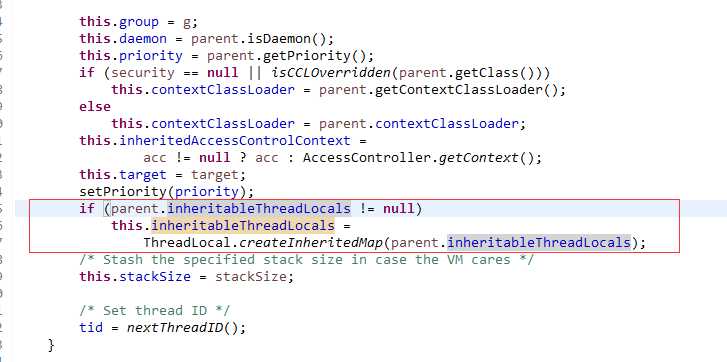
调用createInheritedMap方法,并调用childValue方法复制一份变量给子线程
1 static ThreadLocalMap createInheritedMap(ThreadLocalMap parentMap) {
2 return new ThreadLocalMap(parentMap);
3 }
4
5 private ThreadLocalMap(ThreadLocalMap parentMap) {
6 Entry[] parentTable = parentMap.table;
7 int len = parentTable.length;
8 setThreshold(len);
9 table = new Entry[len];
10
11 for (int j = 0; j < len; j++) {
12 Entry e = parentTable[j];
13 if (e != null) {
14 @SuppressWarnings("unchecked")
15 ThreadLocal<Object> key = (ThreadLocal<Object>) e.get();
16 if (key != null) {
17 Object value = key.childValue(e.value);
18 Entry c = new Entry(key, value);
19 int h = key.threadLocalHashCode & (len - 1);
20 while (table[h] != null)
21 h = nextIndex(h, len);
22 table[h] = c;
23 size++;
24 }
25 }
26 }
27 }
2.支持用户自定义childValue函数,用以子类获取父类变量值的转换:父类变量----childValue转换函数-----》子类变量
InheritableThreadLocal默认childValue函数是直接返回:
protected T childValue(T parentValue) {
return parentValue;
}
用户可在创建InheritableThreadLocal变量时,覆盖childValue函数,见3.3测试
1 package threadLocal;
2
3
4 /**
5 *
6 * @ClassName:MyInheritableThreadLocal
7 * @Description:可继承线程本地变量
8 * @author denny.zhang
9 * @date 2017年12月7日下午5:24:40
10 */
11 public class MyInheritableThreadLocal{
12 //线程本地共享变量
13 private static final InheritableThreadLocal<Object> threadLocal = new InheritableThreadLocal<Object>(){
14 /**
15 * ThreadLocal没有被当前线程赋值时或当前线程刚调用remove方法后调用get方法,返回此方法值
16 */
17 @Override
18 protected Object initialValue()
19 {
20 System.out.println("[线程"+Thread.currentThread().getName()+"]调用get方法时,当前线程共享变量没值,调用initialValue获取默认值!");
21 return null;
22 }
23
24 @Override
25 protected Object childValue(Object parentValue) {
26 return (Integer)parentValue*2;
27 }
28
29 };
30
31 public static void main(String[] args){
32 //主线程设置1
33 threadLocal.set(1);
34 //1.开启任务1线程
35 new Thread(new MyIntegerTask("IntegerTask1")).start();
36 //2.中间休息3秒,用以测试数据差异
37 try {
38 Thread.sleep(3000);
39 } catch (InterruptedException e) {
40 e.printStackTrace();
41 }
42 //开启任务2线程
43 new Thread(new MyIntegerTask("IntegerTask2")).start();
44 }
45
46 /**
47 *
48 * @ClassName:MyIntegerTask
49 * @Description:整形递增线程
50 * @author diandian.zhang
51 * @date 2017年12月4日上午10:00:41
52 */
53 public static class MyIntegerTask implements Runnable{
54 private String name;
55
56 MyIntegerTask(String name)
57 {
58 this.name = name;
59 }
60
61 @Override
62 public void run()
63 {
64 for(int i = 0; i < 5; i++)
65 {
66 // ThreadLocal.get方法获取线程变量
67 if(null == MyInheritableThreadLocal.threadLocal.get())
68 {
69 // ThreadLocal.set方法设置线程变量
70 MyInheritableThreadLocal.threadLocal.set(0);
71 System.out.println("i="+i+"[线程" + name + "]当前线程不存在缓存,set 0");
72 }
73 else
74 {
75 int num = (Integer)MyInheritableThreadLocal.threadLocal.get();
76 System.out.println("i="+i+"[线程" + name + "]get=" + num);
77 MyInheritableThreadLocal.threadLocal.set(num + 1);
78 System.out.println("i="+i+"[线程" + name + "]往threadLocal中set: " + MyInheritableThreadLocal.threadLocal.get());
79 //当i=3即循环4次时,移除当前线程key
80 if(i == 3)
81 {
82 System.out.println("i="+i+"[线程" + name + "],remove" );
83 MyInheritableThreadLocal.threadLocal.remove();
84 }
85 }
86 try
87 {
88 Thread.sleep(1000);
89 }
90 catch (InterruptedException e)
91 {
92 e.printStackTrace();
93 }
94 }
95 }
96 }
97 }
运行结果:
主线程变量值=1-----》主线程中变量值1
i=0[线程IntegerTask1]get=2-----》子线程1中变量值=2*1=2,验证通过! i=0[线程IntegerTask1]往threadLocal中set: 3 i=1[线程IntegerTask1]get=3 i=1[线程IntegerTask1]往threadLocal中set: 4 i=2[线程IntegerTask1]get=4 i=2[线程IntegerTask1]往threadLocal中set: 5 i=0[线程IntegerTask2]get=2-----》主线程2中变量值=2*1=2,验证通过! i=0[线程IntegerTask2]往threadLocal中set: 3 i=3[线程IntegerTask1]get=5 i=3[线程IntegerTask1]往threadLocal中set: 6 i=3[线程IntegerTask1],remove i=1[线程IntegerTask2]get=3 i=1[线程IntegerTask2]往threadLocal中set: 4 [线程Thread-0]调用get方法时,当前线程共享变量没值,调用initialValue获取默认值! i=4[线程IntegerTask1]当前线程不存在缓存,set 0 i=2[线程IntegerTask2]get=4 i=2[线程IntegerTask2]往threadLocal中set: 5 i=3[线程IntegerTask2]get=5 i=3[线程IntegerTask2]往threadLocal中set: 6 i=3[线程IntegerTask2],remove [线程Thread-1]调用get方法时,当前线程共享变量没值,调用initialValue获取默认值! i=4[线程IntegerTask2]当前线程不存在缓存,set 0
如上图,分析结果我们可知,
1.子线程根据childValue函数获取到了父线程的变量值。
2.多线程InheritableThreadLocal变量各自维护,无竞争关系。
子线程变量数据依赖父线程变量,且自定义赋值函数。
例如:
开启多线程执行任务时,总任务名称叫mainTask 子任务名称依次递增mainTask-subTask1、mainTask-subTask2、mainTask-subTaskN等等
本文分析了ThreadLocal原理、set(散列算法原理和测试验证,再哈希扩容)、get、remove源码,实际中的应用场景以及功能测试验证。最后又分析了InheritableThreadLocal,使用该类子线程会继承父线程变量,并自定义赋值函数。
读完本文,相信大家对ThreadLocal一点也不担心了哈哈!
需要注意2点:
1.ThreadLocal不是用来解决线程安全问题的,多线程不共享,不存在竞争!目的是线程本地变量且只能单个线程内维护使用。
2.InheritableThreadLocal对比ThreadLocal唯一不同是子线程会继承父线程变量,并自定义赋值函数。
3.项目如果使用了线程池,那么小心线程回收后ThreadLocal、InheritableThreadLocal变量要remove,否则线程池回收后,变量还在内存中,后果不堪设想!(例如Tomcat容器的线程池,可以在拦截器中处理:extends HandlerInterceptorAdapter,然后复写afterCompletion方法,remove掉变量!!!)
标签:存储 斐波那契 exce 回收对象 追踪 源码分析 不能 slots soc
原文地址:https://www.cnblogs.com/gxyandwmm/p/9445875.html